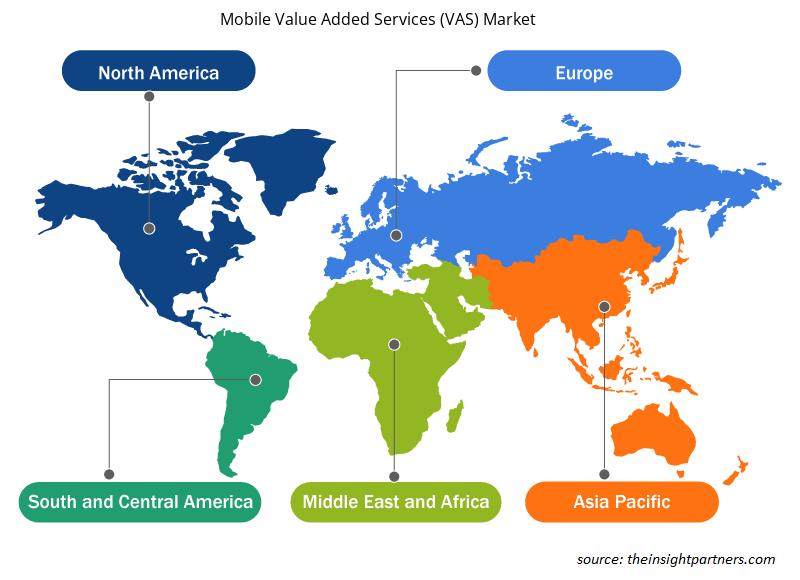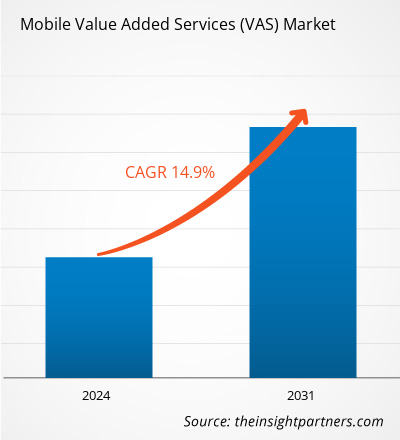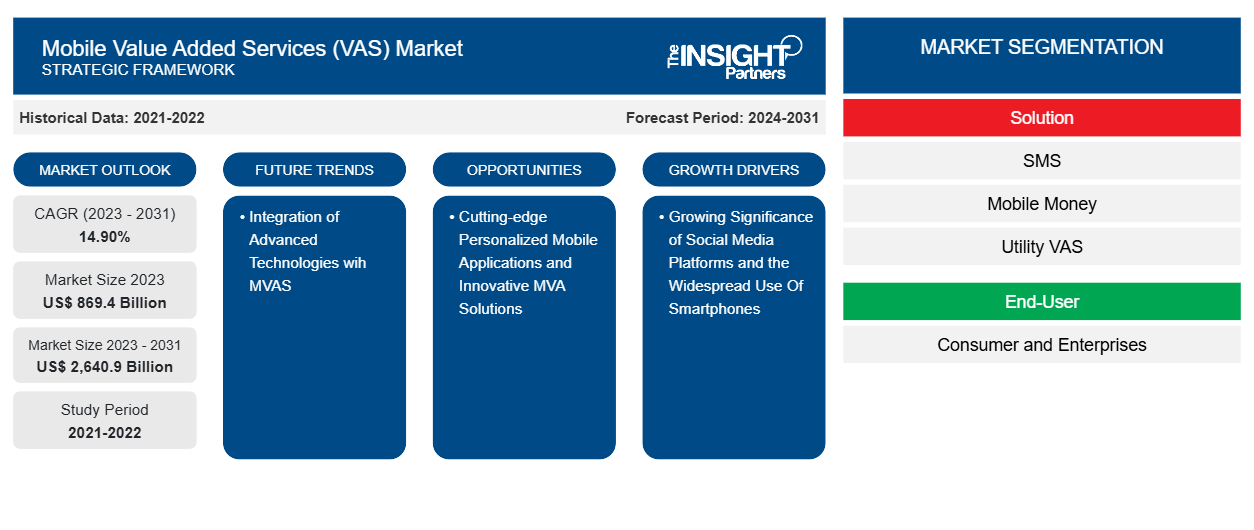Si prevede che la dimensione del mercato dei servizi a valore aggiunto (VAS) mobili raggiungerà i 2.640,9 miliardi di dollari entro il 2031, rispetto agli 869,4 miliardi di dollari del 2023. Si prevede che il mercato registrerà un CAGR del 14,90% nel periodo 2023-2031. La crescente implicazione delle piattaforme di social media e l'uso diffuso degli smartphone rimarranno probabilmente le principali tendenze del mercato dei servizi a valore aggiunto (VAS) mobili.
Analisi del mercato dei servizi a valore aggiunto (VAS) mobili
La facilità di accesso a contenuti misti e rinnovati a costi ragionevoli sta aumentando la crescita OTT, che è una parte dei servizi a valore aggiunto mobili. Le aziende di telecomunicazioni offrono VAS collaborando con piattaforme di visualizzazione online nel settore dell'intrattenimento, come Netflix. Tali collaborazioni contribuiscono a VAS in termini di pagamenti, distribuzione di contenuti, marketing interattivo e assistenza clienti.
Panoramica del mercato dei servizi a valore aggiunto (VAS) mobili
I servizi a valore aggiunto mobili (MVAS) includono servizi di comunicazione vocale e altri servizi aggiuntivi forniti dai provider di servizi mobili. Questi servizi consentono agli abbonati mobili di utilizzare smartphone e tablet per vari scopi non vocali, tra cui l'invio di servizi di messaggistica breve (SMS), servizi di messaggistica multimediale (MMS), e-mail mobile e messaggistica istantanea, denaro mobile, servizi basati sulla posizione, pubblicità mobile e infotainment mobile. I MVAS sono commercializzati come funzionalità premium o supplementi ai servizi essenziali e sono utilizzati per creare efficienze amministrative e operative in un'ampia gamma di servizi. Offrono vantaggi sia ai provider di servizi che ai clienti aumentando la funzionalità dell'utente finale e fornendo analisi e dati migliorati per l'uso commerciale.
Personalizza questo report in base alle tue esigenze
Riceverai la personalizzazione gratuita di qualsiasi report, comprese parti di questo report, o analisi a livello nazionale, pacchetto dati Excel, oltre a usufruire di grandi offerte e sconti per start-up e università
- Scopri le principali tendenze di mercato in questo rapporto.Questo campione GRATUITO includerà analisi di dati che spaziano dalle tendenze di mercato alle stime e alle previsioni.
Driver e opportunità del mercato dei servizi a valore aggiunto mobili (VAS)
Crescente importanza delle piattaforme di social media e uso diffuso degli smartphone
Un'ampia varietà di venditori e una massiccia concorrenza tra i provider di servizi Internet stanno implementando soluzioni digitali, applicazioni avanzate e numerosi servizi a valore aggiunto . Gli smartphone vengono utilizzati per accedere a varie applicazioni Internet, come la navigazione di siti Web online, la condivisione di e-mail e l'interazione su piattaforme di social media. I provider di telecomunicazioni offrono un'ampia gamma di servizi a valore aggiunto mobili, tra cui servizi vocali, SMS e dati, tra gli altri servizi aggiuntivi, per migliorare l'esperienza complessiva dell'utente. La crescente disponibilità di smartphone economici è un fattore chiave che stimola l'adozione di dispositivi tra le popolazioni a basso reddito, il che contribuisce alla domanda di servizi a valore aggiunto mobili in tutto il mondo. Pertanto, la crescente importanza delle piattaforme di social media e l'uso diffuso di smartphone sono fattori chiave che alimentano la crescita del mercato dei servizi a valore aggiunto mobili (VAS).SMS, and data services, among other additional services, to improve the overall user experience. The growing availability of budget-friendly smartphones is a key factor boosting device adoption among the populations with low income, which contributes to the demand for mobile value added services worldwide. Thus, the growing significance of social media platforms and the widespread use of smartphones are key factors fueling the mobile value added service (VAS) market growth.
Applicazioni mobili personalizzate all'avanguardia e soluzioni MVA innovativeMVA Solutions
Una vasta gamma di applicazioni mobili personalizzate e innovative e servizi a valore aggiunto (VAS) mobili vengono introdotte dagli operatori di telecomunicazioni e dai fornitori di servizi in tutto il mondo per rispondere alle mutevoli esigenze dei consumatori. L'ambiente dinamico del mercato è modellato da fattori quali la crescente popolazione di abbonati VAS mobili e utenti di smartphone. Inoltre, il desiderio di servizi a valore aggiunto personalizzati da parte sia delle aziende che dei consumatori contribuisce all'espansione del mercato dei servizi a valore aggiunto (VAS) mobili. Questa tendenza evidenzia l'impegno del settore nel soddisfare le mutevoli esigenze di consumatori e aziende attraverso soluzioni e servizi mobili all'avanguardia.VAS) are being introduced by telecom operators and service providers worldwide to address evolving consumer demands. The dynamic market environment is shaped by factors such as the growing population of mobile VAS subscribers and smartphone users. Moreover, the desire for tailored value added services from both businesses and consumers contributes to the expansion of the mobile value added services (VAS) market. This trend highlights the industry's commitment to meeting the evolving needs of consumers and businesses through cutting-edge mobile solutions and services.
Analisi della segmentazione del rapporto di mercato sui servizi a valore aggiunto (VAS) per dispositivi mobili
I segmenti chiave che hanno contribuito alla derivazione dell'analisi di mercato dei servizi a valore aggiunto (VAS) mobili sono la soluzione e l'utente finale.
- In base alla soluzione, il mercato è segmentato in SMS, denaro mobile, utility VAS, infotainment mobile, social networking, servizi basati sulla posizione e altri. Il segmento SMS ha detenuto una quota di mercato sostanziale nel 2023.
- Per utente finale, il mercato è diviso in consumatori e imprese. Il segmento dei consumatori ha detenuto una quota significativa del mercato nel 2023.
Analisi della quota di mercato dei servizi a valore aggiunto (VAS) per area geografica
L'ambito geografico del rapporto sul mercato dei servizi a valore aggiunto (VAS) mobili è suddiviso principalmente in cinque regioni: Nord America, Asia Pacifico, Europa, Medio Oriente e Africa, Sud e Centro America.
L'Asia Pacifica ha un numero elevato di utenti di telefoni cellulari e questi dispositivi sono utilizzati principalmente per scopi di intrattenimento, come guardare notizie e film, servizi bancari mobili, ecc. La crescita del mercato dei servizi a valore aggiunto mobili (VAS) nell'Asia Pacifica è attribuita al crescente numero di aziende e settori verticali che utilizzano vari servizi a valore aggiunto mobili e alla presenza di fiorenti settori del commercio al dettaglio, dell'e-commerce e dell'IT e delle telecomunicazioni nella regione.
Approfondimenti regionali sul mercato dei servizi a valore aggiunto (VAS) per dispositivi mobili
Le tendenze regionali e i fattori che influenzano il mercato dei servizi a valore aggiunto (VAS) per dispositivi mobili durante il periodo di previsione sono stati ampiamente spiegati dagli analisti di Insight Partners. Questa sezione discute anche i segmenti di mercato dei servizi a valore aggiunto (VAS) per dispositivi mobili e la geografia in Nord America, Europa, Asia Pacifico, Medio Oriente e Africa e Sud e Centro America.

- Ottieni i dati specifici regionali per il mercato dei servizi a valore aggiunto mobili (VAS)
Ambito del rapporto di mercato sui servizi a valore aggiunto (VAS) mobili
| Attributo del report | Dettagli |
|---|---|
| Dimensioni del mercato nel 2023 | 869,4 miliardi di dollari USA |
| Dimensioni del mercato entro il 2031 | 2.640,9 miliardi di dollari USA |
| CAGR globale (2023-2031) | 14,90% |
| Dati storici | 2021-2022 |
| Periodo di previsione | 2024-2031 |
| Segmenti coperti | Per soluzione
|
| Regioni e Paesi coperti | America del Nord
|
| Leader di mercato e profili aziendali chiave |
|
Densità degli attori del mercato dei servizi a valore aggiunto (VAS) mobili: comprendere il suo impatto sulle dinamiche aziendali
Il mercato dei servizi a valore aggiunto (VAS) per dispositivi mobili sta crescendo rapidamente, spinto dalla crescente domanda degli utenti finali dovuta a fattori quali l'evoluzione delle preferenze dei consumatori, i progressi tecnologici e una maggiore consapevolezza dei vantaggi del prodotto. Con l'aumento della domanda, le aziende stanno ampliando le loro offerte, innovando per soddisfare le esigenze dei consumatori e capitalizzando sulle tendenze emergenti, il che alimenta ulteriormente la crescita del mercato.
La densità degli operatori di mercato si riferisce alla distribuzione di aziende o società che operano in un particolare mercato o settore. Indica quanti concorrenti (operatori di mercato) sono presenti in un dato spazio di mercato in relazione alle sue dimensioni o al valore di mercato totale.
Le principali aziende che operano nel mercato dei servizi a valore aggiunto mobili (VAS) sono:
- EITC
- Airtel (Robi Axiata Limited)
- Mobilità
- MTN CAMERUN
- Numeko Bili?im Teknoloji Sanayi Ticaret A.?.
- Società di telecomunicazioni dell'Oman
Disclaimer : le aziende elencate sopra non sono classificate secondo un ordine particolare.

- Ottieni una panoramica dei principali attori del mercato dei servizi a valore aggiunto (VAS) per dispositivi mobili
Notizie e sviluppi recenti sul mercato dei servizi a valore aggiunto (VAS) mobili
Il mercato dei servizi a valore aggiunto (VAS) mobili viene valutato raccogliendo dati qualitativi e quantitativi dopo la ricerca primaria e secondaria, che include importanti pubblicazioni aziendali, dati associativi e database. Di seguito sono elencati alcuni degli sviluppi nel mercato dei servizi a valore aggiunto (VAS) mobili:
- Monty Mobile, la società di telecomunicazioni globale in rapida crescita che offre soluzioni innovative di tecnologia e comunicazione, ha annunciato l'integrazione di intelligenza artificiale e apprendimento automatico nei suoi servizi a valore aggiunto (VAS). Questa integrazione, denominata OmniVAS, consentirà agli operatori di telefonia mobile di raddoppiare i propri ricavi in pochissimo tempo. Sfruttando il data mining, questa soluzione di intelligenza artificiale all'avanguardia analizza automaticamente il comportamento dei consumatori, ottimizzando l'upselling e il cross-selling, che hanno un effetto diretto sull'aumento della soddisfazione del cliente e quindi sull'aumento dei ricavi per gli operatori attraverso l'aumento delle vendite, migliorando la loro comprensione del comportamento dei clienti attraverso l'apprendimento automatico e intuizioni illuminanti, consentendo loro di prendere decisioni e previsioni intelligenti. (Fonte: Monty Mobile, comunicato stampa, 2023)
- Clickatell, leader nel Chat Commerce e nella messaggistica aziendale, ha lanciato la sua funzionalità Chat 2 Pay per la più grande azienda di comunicazioni integrate del Sudafrica, Telkom. I milioni di clienti di Telkom possono ora effettuare pagamenti su WhatsApp, il più grande canale di chat del Paese. (Fonte: Clickatell, sito Web aziendale, 2023)
Copertura e risultati del rapporto sul mercato dei servizi a valore aggiunto (VAS) per dispositivi mobili
Il rapporto “Dimensioni e previsioni del mercato dei servizi a valore aggiunto mobili (VAS) (2021-2031)” fornisce un’analisi dettagliata del mercato che copre le seguenti aree:
- Dimensioni e previsioni del mercato dei servizi a valore aggiunto (VAS) mobili a livello globale, regionale e nazionale per tutti i segmenti di mercato chiave coperti dall'ambito
- Tendenze del mercato dei servizi a valore aggiunto mobili (VAS) e dinamiche di mercato quali driver, vincoli e opportunità chiave
- Analisi dettagliata delle cinque forze PEST/Porter e SWOT
- Analisi di mercato dei servizi a valore aggiunto mobili (VAS) che copre le principali tendenze di mercato, il quadro globale e regionale, i principali attori, le normative e i recenti sviluppi del mercato
- Analisi del panorama industriale e della concorrenza che copre la concentrazione del mercato, l'analisi della mappa di calore, i principali attori e gli sviluppi recenti per il mercato dei servizi a valore aggiunto (VAS) mobili
- Profili aziendali dettagliati
- Analisi storica (2 anni), anno base, previsione (7 anni) con CAGR
- Analisi PEST e SWOT
- Valore/volume delle dimensioni del mercato - Globale, Regionale, Nazionale
- Industria e panorama competitivo
- Set di dati Excel
Report recenti
Testimonianze
Motivo dell'acquisto
- Processo decisionale informato
- Comprensione delle dinamiche di mercato
- Analisi competitiva
- Analisi dei clienti
- Previsioni di mercato
- Mitigazione del rischio
- Pianificazione strategica
- Giustificazione degli investimenti
- Identificazione dei mercati emergenti
- Miglioramento delle strategie di marketing
- Aumento dell'efficienza operativa
- Allineamento alle tendenze normative





















 Ottieni un campione gratuito per - Mercato dei servizi a valore aggiunto (VAS) mobili
Ottieni un campione gratuito per - Mercato dei servizi a valore aggiunto (VAS) mobili